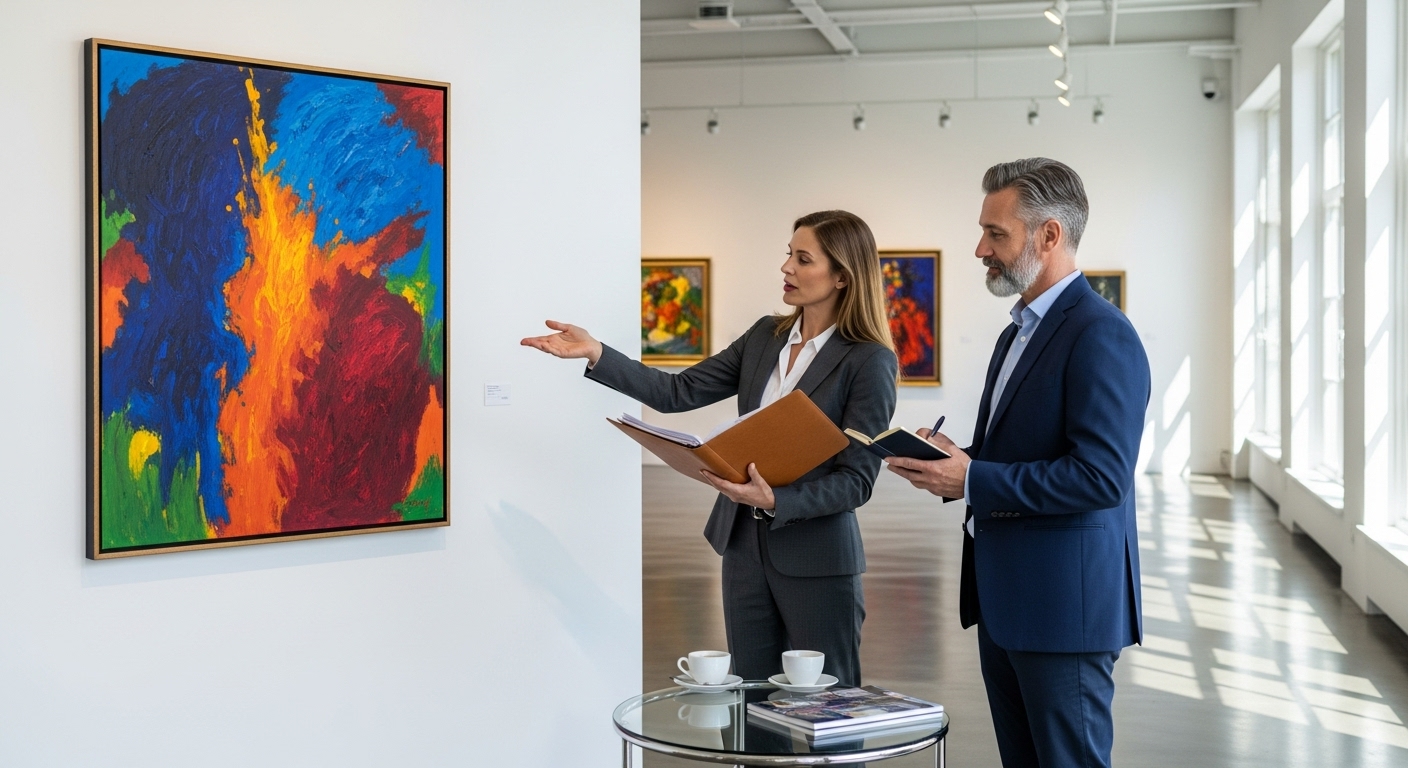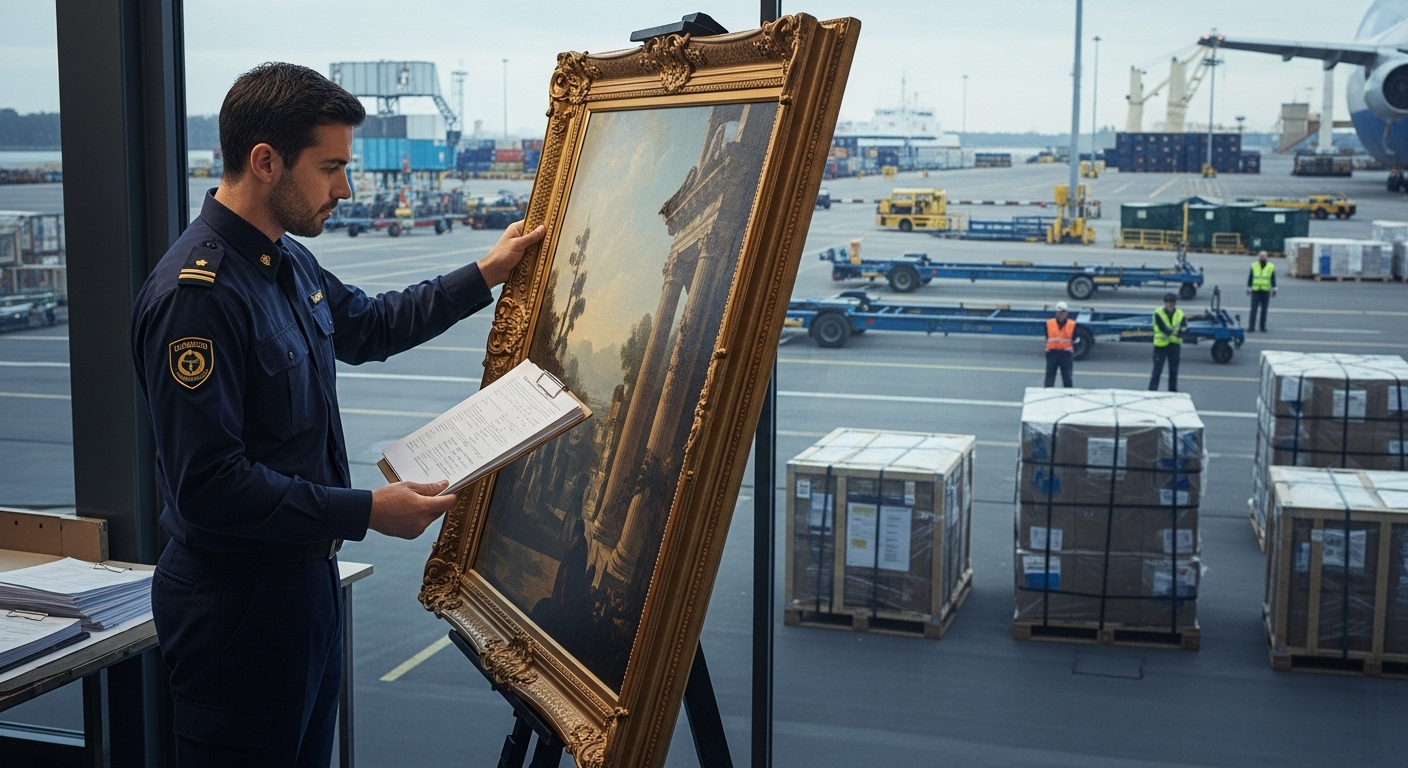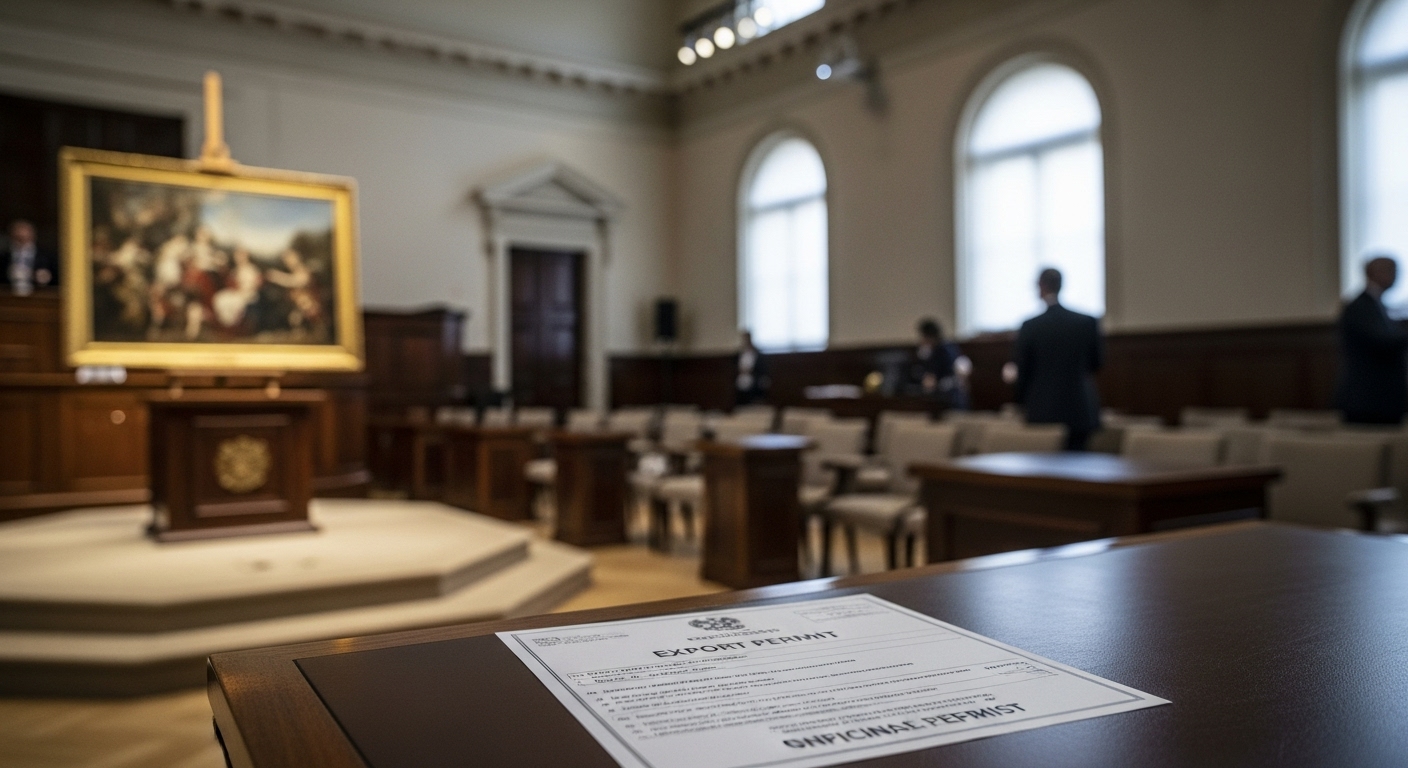Permission to Export Paintings: How to Prepare Works for Sale Through Christie’s and Sotheby’s

Selling works of art through international auction houses is a process that requires exceptional responsibility, knowledge, and preparation. Christie’s and Sotheby’s are not just major global marketplaces - they are the central verification points of the international art market. They accept only those artworks whose provenance and authenticity are unquestionable and whose legal status is fully confirmed.
Therefore, if the artwork is located in Ukraine, obtaining an official permission to export a painting from Ukraine becomes an essential part of the process.
The global art market demands transparency. Auction houses thoroughly review every work to eliminate the risk of illegal export of cultural valuables, counterfeit pieces, or questionable transactions. Ukrainian legislation works in full alignment with international norms: no artwork can legally leave the country without a proper expert assessment and an officially issued export permit.
This article explains in detail why the procedure is mandatory, how the export process works, which common mistakes sellers make, and how to prepare your artwork so that Christie’s or Sotheby’s accepts it without a single remark.
Why International Auctions Require an Official Export Permit
What Is Considered a Cultural Asset: Paintings, Icons, Sculptures, and Graphics
The definition of “cultural asset” in Ukrainian law is extremely broad. Even a contemporary painting, as long as it is an original artwork, may fall into a category requiring a permit. This applies not only to historical or museum-level works but also to the modern art market - especially when it comes to export of paintings, unique graphic works, or export of icons, which are subject to especially strict control.
Auction houses never accept pieces with questionable provenance. If a work crosses the border without proper documentation, it is automatically considered high-risk.
Why Auction Houses Require Provenance and Export Permission
Christie’s and Sotheby’s build their reputation on complete transparency. Every submitted artwork undergoes several layers of verification - legal, expert, and technical. Auction houses must ensure that:
- the work was exported legally,
- it carries no disputed status,
- its provenance is confirmed,
- all documents comply with international legal requirements.
For this reason, Ukrainian export documentation is as important as the documentation provided by owners from any other country.
What Sellers Risk If Documentation Is Missing
Sending an artwork abroad without an official permission to export paintings is not just a risk of shipping delays - it may result in:
- cancellation of the sale,
- withdrawal from the auction,
- legal complications,
- reputational damage.
A painting may be detained by:
- Ukrainian customs,
- customs of the recipient country,
- or by the auction house itself.
In the worst case, the artwork may be seized until all circumstances are clarified, and collaboration with the auction house may be terminated.
Center for packaging valuable and fragile items in Ukraine – https://packingcentre.com.ua/
Specifics of Exporting Paintings from Ukraine for Sale Through Christie’s and Sotheby’s
Export of artworks from Ukraine is strictly regulated, especially if the piece is to be presented at major international auctions such as Christie’s or Sotheby’s. Any painting, icon, graphic work, or sculpture may qualify as a cultural asset. Before the artwork leaves the country, it must undergo expert evaluation to determine its authenticity, artistic significance, date of creation, technique, and condition.
Even contemporary works, if they are originals, require official confirmation, as the law considers them potentially valuable cultural property.
An export permit is required not only for antique works. It is obligatory if:
- the artwork was created before 1950;
- the export involves icons (even contemporary ones);
- the export includes sculptures;
- the piece has artistic or historical significance;
- the work is being submitted to an international auction.
Any work directed to Christie’s or Sotheby’s automatically requires official documentation, regardless of its age.
The range of objects that must undergo expert evaluation is very broad: original paintings, author graphics, icons, sculptures, religious objects, and decorative art. Only purely souvenir products are exempt - but determining this without an expert is practically impossible.
Therefore, any doubt should always be resolved through a certified expert to avoid risks at the border.
Preparing a Painting for Submission to an International Auction
What You Must Provide to the Auction House: Photos, Description, Provenance
Auction houses require complete and accurate information about the artwork. This includes:
- high-quality photographs,
- full description of technique and materials,
- details about the artist,
- provenance documentation,
- previous appraisals and sales history.
Without this information, the artwork will not be considered for the auction.
Why It’s Important to Obtain the Expert Assessment in Advance
A professional expert conclusion on paintings, art, and fine arts is not a formality but a mandatory requirement. The expert conclusion:
- establishes provenance,
- confirms the date of creation,
- describes the key parameters of the artwork,
- determines artistic value.
Without the expert report, obtaining an export permit is impossible.
How to Prove Authenticity and Age Before the Export
Several types of verification may be involved:
- art-historical analysis,
- technological examination of pigments and materials,
- archival research,
- signature authentication,
- comparison with other verified works of the artist.

How Expert Evaluation Is Conducted Before Issuing a Painting Export Permit
Who Has the Right to Conduct Expert Examination
Expert assessments are carried out by:
- state institutions,
- accredited expert centers,
- certified art historians.
Only such experts can produce documents valid for international export.
What Data the Expert Conclusion Includes
A standard expert assessment for export of paintings or artworks contains:
- photos of the artwork,
- technique and materials,
- dimensions,
- description,
- date of creation,
- evaluation of cultural value,
- final decision authorizing or prohibiting export.
What the Sample Expert Conclusion Looks Like
A sample expert conclusion for export of paintings typically includes:
- structured description,
- expert analysis,
- signatures,
- seals,
- a registration number.
This document must be attached to the application for permission to export a painting from Ukraine.
Step-by-Step Process of Obtaining Permission to Export a Painting from Ukraine
Where to Apply and Which Documents to Prepare
The export permit is issued by authorized Ukrainian cultural institutions.
To submit the application, you need:
- the artwork itself,
- photographs,
- an official expert conclusion,
- an application form,
- documents confirming ownership.
These materials form the core of the submission required to legally export the artwork.
How to Correctly Complete the Export Permit Application
The application must include:
- accurate information about the artwork,
- the purpose of export,
- full details of the recipient,
- name of the auction house (Christie’s, Sotheby’s),
- expected duration of export or sale.
The application must reflect all relevant details precisely; even minor discrepancies can lead to delays or rejection.
Timelines and Possible Reasons for Refusal
The standard review time is 3 to 10 business days, depending on:
- the workload of the expert institution,
- the complexity of the artwork,
- the volume of submitted applications.
Refusals may occur due to:
- incorrect or incomplete information,
- low-quality photographs,
- inconsistencies between documents and the actual artwork,
- questionable provenance,
- missing expert documentation.
How to Prepare the Artwork for International Transportation
Christie’s and Sotheby’s Requirements for Packaging and Safety
Auction houses demand museum-level packing standards. This typically includes:
- rigid, impact-resistant crates,
- secure internal fixation,
- corner protection,
- multi-layer cushioning,
- climate control (for sensitive materials).
They must ensure that the artwork arrives in the exact condition in which it was approved for sale.
Specifics of Exporting Paintings, Icons, and Sculptures
- Export of paintings requires special protection for the pigment layer.
- Export of icons requires stability and protection of wooden boards.
- Export of sculptures demands rigid fixation and high-strength crates.
Each medium has its own vulnerabilities, and auction houses expect sellers to provide proper conservation-level protection.
Where to Arrange Transport: Specialized Art Logistics or Courier Services
For artworks submitted to Christie’s or Sotheby’s, only specialized art logistics companies are recommended.
Courier services lack:
- required insurance coverage,
- climate control,
- secure handling standards,
- the ability to process customs documents for cultural valuables.
Therefore, for high-value pieces, professional art transport is the only acceptable option.
What Happens on the Auction House Side After Receiving the Export Permit
Verification of Documentation and Confirmation of Eligibility for Sale
Legal teams at Christie’s and Sotheby’s verify:
- the legitimacy of the export permit,
- the validity of the expert conclusion,
- proper provenance records.
Only after approval the artwork is allowed to proceed to the next stage.
Internal Audit of Authenticity and Artwork History
The artwork undergoes additional checks:
- verification of authorship,
- review of archival records,
- confirmation of exhibition history,
- comparison with catalogues raisonnés,
- review of previous sales records.
Auction houses critically evaluate the integrity of the work’s history.
How the Preliminary Auction Estimate Is Formed
Assessment is based on:
- the artist’s name and market recognition,
- rarity of the work,
- its condition and preservation,
- demand levels on the current art market,
- provenance depth,
- exhibition record.
The better the documentation - the higher the valuation.
Common Mistakes When Obtaining Export Permits for Auction Sales
In practice, many artwork owners face difficulties primarily because of poorly prepared documentation. Problems most often occur when:
- the expert conclusion is improperly completed or deviates from standard formats,
- the description of the artwork does not match its actual characteristics,
- documentation is incomplete (missing photographs, missing pages, lack of provenance),
- the export permit is obtained too late, causing missed auction deadlines.
Christie’s and Sotheby’s operate on strict schedules, so any delay in documentation can disqualify a painting from being included in the sale.
Useful Recommendations for Sellers Participating in International Auctions
To avoid complications, sellers should begin the documentation process early. Never postpone expert evaluation or export permit filing to the last minute.
Maintaining a well-organized archive of all important materials is essential:
- expert conclusions,
- provenance records,
- historical photographs,
- previous valuation documents,
- contracts and sales history.
For valuable, rare, or historically complex artworks, it is highly advisable to work with professional art-logistics companies and specialized art experts. This significantly reduces risks and saves time.

FAQ: Export Permits for Selling Artworks at Christie’s and Sotheby’s
1. Do I need documents if I want to know how to send a painting abroad from Ukraine for an auction?
Yes. Every owner must obtain an official permission to export a painting from Ukraine, regardless of how “simple” or “contemporary” the artwork is. Auction houses accept only fully legal shipments.
2. Which artworks require expert evaluation before the export of paintings from Ukraine?
Expert evaluation is mandatory for almost all original works, including:
- export of paintings,
- author graphics,
- export of icons,
- export of sculptures.
Even contemporary works are examined for cultural value and authenticity.
3. Who conducts the expert conclusion on paintings, art, and fine arts?
Certified specialists:
- state institutions,
- accredited expert centers,
- professional art historians.
Only documents issued by such experts are accepted by Ukrainian authorities and international auction houses.
4. What does a sample expert conclusion for export of paintings include?
It must contain:
- high-quality photos,
- materials and technique,
- dimensions,
- date of creation,
- condition analysis,
- assessment of cultural value,
- export authorization or prohibition.
This document is necessary for obtaining an official export permit.
5. Is an export permit always required before sending a painting to Christie’s or Sotheby’s?
Yes. Auction houses will not accept any artwork without confirmed legal origin and proper export documentation.
6. Is a painting created in 2020+ considered a cultural asset?
Not always - but only an expert can determine this.
Even modern works may fall under cultural protection depending on their artistic significance.
7. What happens if I send a painting to an auction house without documents?
The artwork may be detained:
- by Ukrainian customs,
- by customs in the destination country,
- by the auction house’s internal compliance team.
Lack of permission to export paintings may lead to seizure, rejection from the auction, and reputational risks.
8. Can I send a painting by mail without an export permit?
No. International postal services are forbidden from shipping artworks without proper documentation.
Classification of the artwork is determined by experts, not by the sender.
9. How long does it take to get the export permit?
On average: 3–10 business days.
10. Do I need a permit if the artwork is returning after the auction?
Yes. Any cross-border movement requires a permit, including temporary export.
11. Can the same permit be used for another auction?
No. Each export is processed individually.
12. Can an expert refuse to issue a conclusion?
Yes. Reasons include:
- questionable authenticity,
- missing or weak provenance,
- undocumented damage,
- the artwork being protected as cultural heritage.
In such cases, export may be prohibited.
13. When is the best time to start documentation for Christie’s or Sotheby’s?
As early as possible - ideally when submitting the artwork for consideration.
Most issues arise due to tight deadlines.
14. Do I need documents if I’m transporting the painting personally?
Yes. The transportation method does not exempt you from legal export requirements.
15. Who can handle all documentation instead of me?
Professional art-logistics companies. They can manage:
- expert assessment,
- export permits,
- packing,
- transport,
- documentation for the auction house.
Conclusion: How to Prepare a Painting for Sale at Christie’s and Sotheby’s Without Risks
Properly prepared expert evaluations and export permits:
- protect the seller,
- strengthen buyer confidence,
- allow participation in global auctions,
- prevent delays and legal problems.
Thorough preparation is not just a technical step - it is the foundation of a successful international sale.
Call us: +380632478102.
Reliable packaging and international delivery of valuable items – https://wellpack.com.ua/
